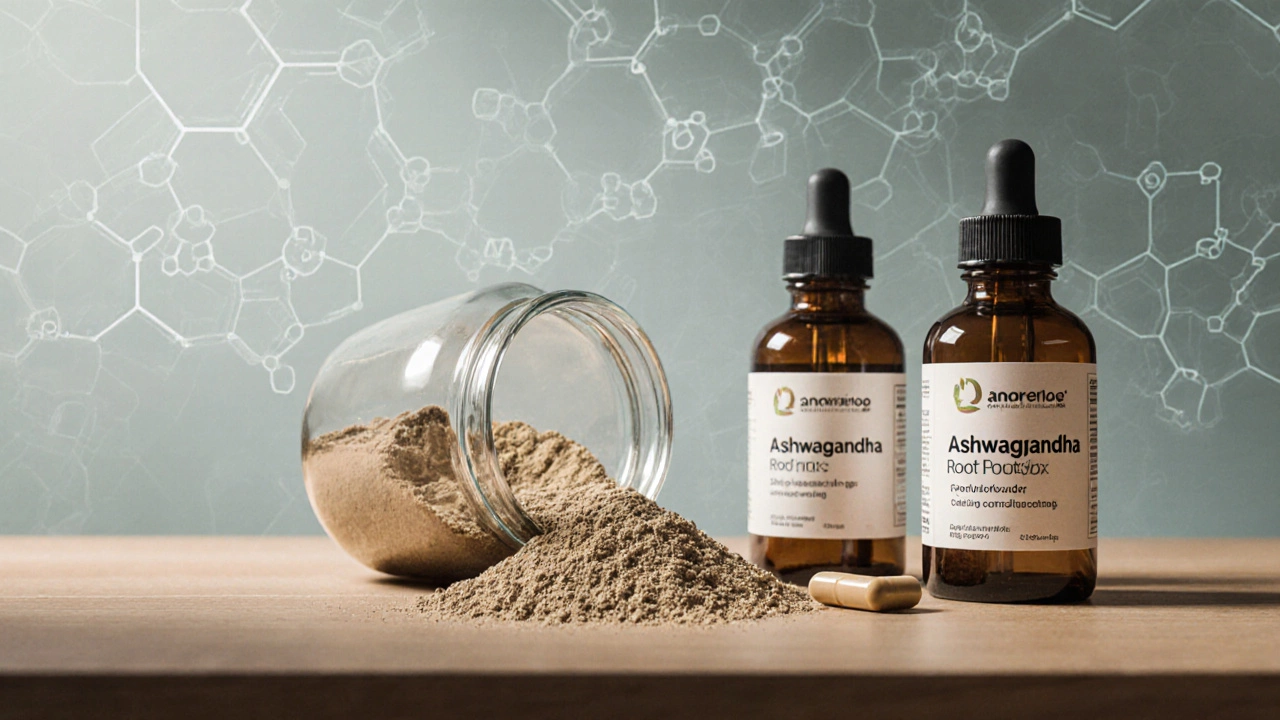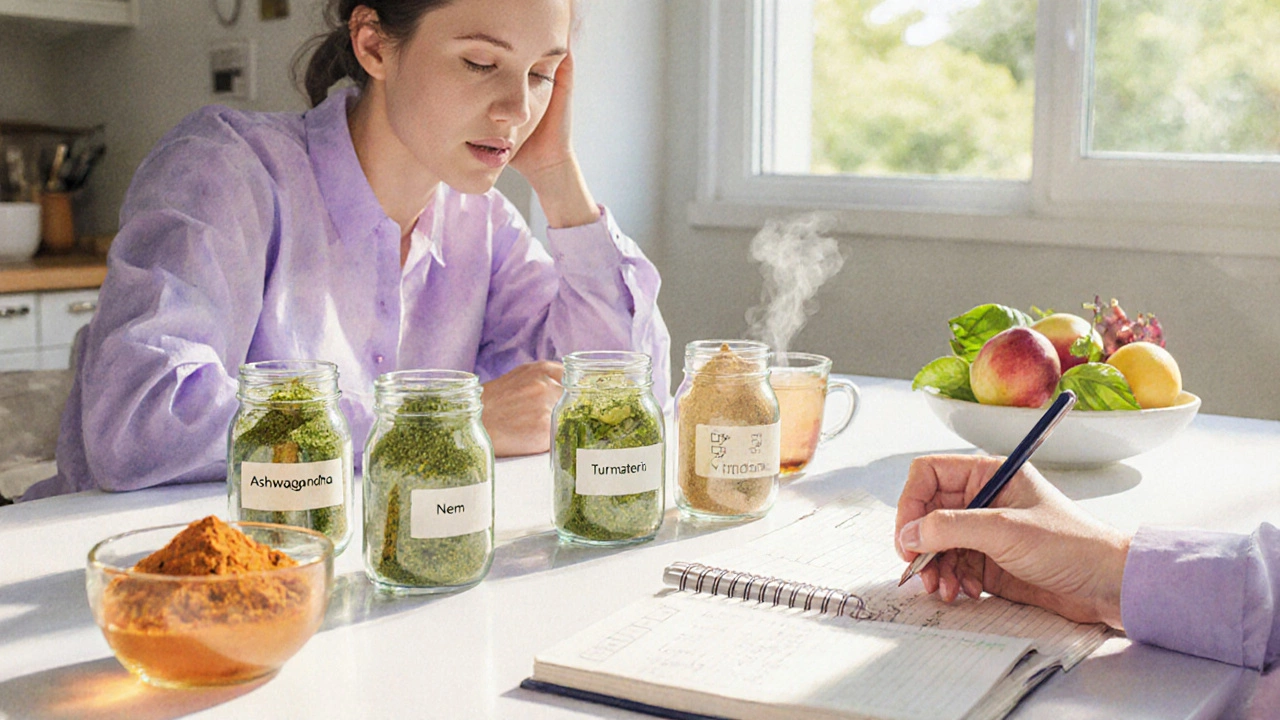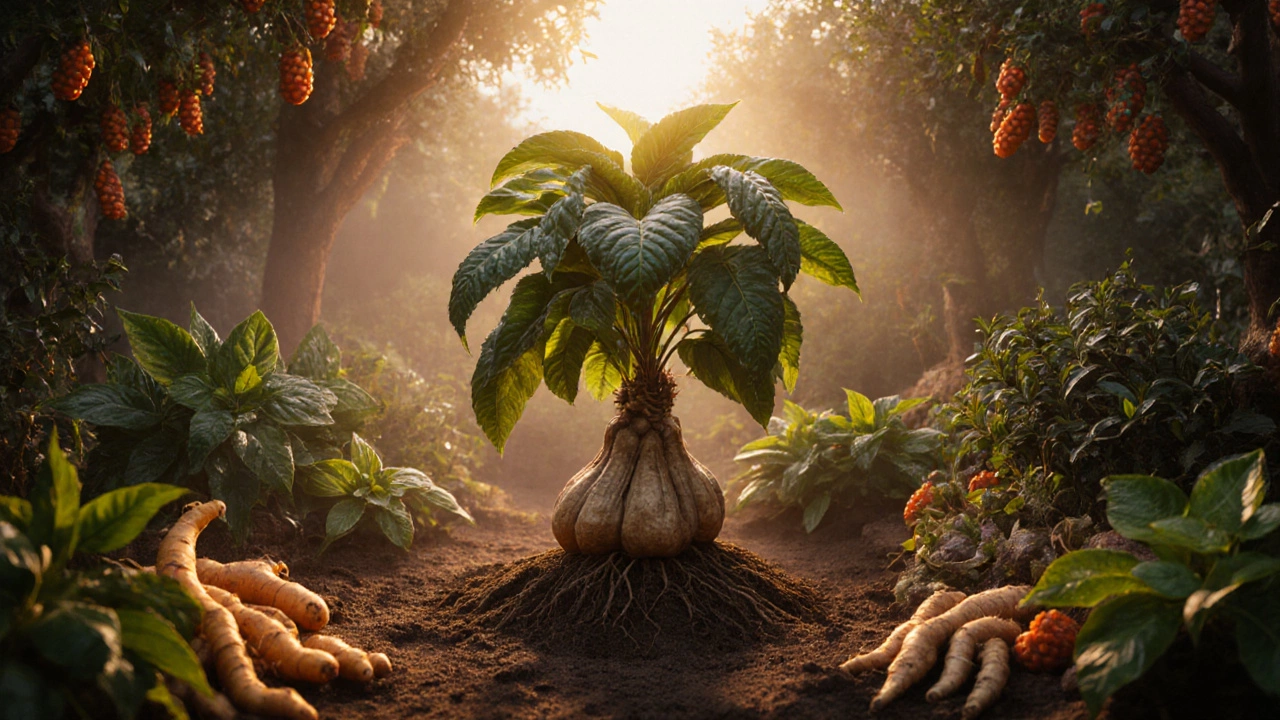Healing Herb Selector
Enter your health goals and conditions above to get personalized recommendations.
Quick Takeaways
- The herb most often hailed as the ultimate healer in Ayurveda is Ashwagandha.
- Its adaptogenic, anti‑inflammatory, and antioxidant properties are backed by modern studies.
- Turmeric, Holy Basil, Neem, Amla, Gotu Kola, Brahmi, and Licorice Root are close rivals with specific strengths.
- Choosing the right herb depends on your primary health goal, dosage tolerance, and possible interactions.
- Start with low doses, monitor effects, and consult a qualified practitioner for long‑term use.
When people ask "What is the most healing herb?" they’re usually after a single plant that can do it all - boost immunity, calm stress, reduce inflammation, and support overall vitality. In reality, the answer blends ancient wisdom with modern science. This guide walks you through the top contenders, explains why one herb often tops the list, and gives you a practical framework to pick the best match for your own health needs.
Understanding What Makes a Herb "Healing"
A "healing" herb is more than just a tasty spice. It typically meets three scientific criteria:
- Active phytochemicals - compounds such as alkaloids, flavonoids, or withanolides that trigger measurable physiological effects.
- Clinical evidence - at least a handful of peer‑reviewed studies showing benefits in humans or well‑designed animal models.
- Safety profile - a low incidence of serious adverse reactions when used at recommended doses.
Ayurveda classifies herbs into categories like rasayana (rejuvenating) and vyadhihara (disease‑curing). The herb that checks all three boxes across multiple health domains usually earns the title of "most healing."
The Top Contender: Ashwagandha
Ashwagandha is a powerful adaptogenic herb used for centuries in Ayurvedic medicine to combat stress, improve stamina, and support hormonal balance. Its primary active chemicals are withanolides, which exhibit anti‑inflammatory, anti‑tumor, and neuroprotective actions. Modern clinical trials (e.g., a 2023 double‑blind study on 150 participants) show that a daily dose of 300‑600mg of a standardized extract can lower cortisol by up to 30% and improve sleep quality by 25%.
Key benefits of Ashwagandha include:
- Stress reduction and cortisol regulation.
- Enhanced muscle strength and recovery - useful for athletes and older adults.
- Improved thyroid function in subclinical hypothyroidism.
- Supports male fertility by increasing sperm motility.
Typical dosage: 300‑600mg of a 5% withanolide standardized root extract taken once or twice daily, preferably with meals.

Close Rivals: Other Powerful Healing Herbs
While Ashwagandha leads the pack, several other herbs excel in specific therapeutic areas. Below is a snapshot of each, marked up for search‑engine clarity.
Turmeric (Curcuma longa) is a bright yellow rhizome celebrated for its anti‑inflammatory curcumin compound. Curcumin has been shown to inhibit NF‑κB pathways, reducing chronic inflammation in conditions like arthritis and metabolic syndrome.
Holy Basil (Ocimum sanctum), also called Tulsi, is a holistic adaptogen that helps balance blood sugar and modulate stress hormones. Clinical data suggest a 250‑mg leaf extract can lower fasting glucose by 7% over 12 weeks.
Neem (Azadirachta indica) is a broad‑spectrum antimicrobial tree bark used for skin infections, blood purification, and parasite control. Neem leaf powder (2-3g daily) has demonstrated efficacy against Candida albicans in vitro.
Amla (Phyllanthus emblica) is a VitaminC‑rich fruit that supports antioxidant defense and collagen synthesis. Regular consumption (1-2g powdered fruit) can boost plasma vitaminC levels by 30%.
Gotu Kola (Centella asiatica) is a herb known for neuro‑vascular benefits, promoting wound healing and cognitive clarity. A 500‑mg extract daily improves microcirculation scores in elderly subjects.
Brahmi (Bacopa monnieri) is a nootropic that enhances memory, reduces anxiety, and protects neurons from oxidative stress. Six weeks of 300mg Bacopa extract can raise information retention by 15%.
Licorice Root (Glycyrrhiza glabra) is a sweet‑tasting herb with anti‑ulcer and adrenal‑supporting properties. D‑gluco‑glycyrrhizin, the active glycoside, helps soothe gastric mucosa and modulate cortisol.
Side‑by‑Side Comparison
| Herb | Primary Active Compounds | Top Therapeutic Benefits | Typical Daily Dose | Safety Highlights |
|---|---|---|---|---|
| Ashwagandha | Withanolides | Stress reduction, immunity, stamina | 300‑600mg extract | Generally safe; avoid high doses if thyroid issues |
| Turmeric | Curcumin | Anti‑inflammatory, joint health | 500‑2000mg curcumin (with piperine) | High doses may irritate stomach; watch blood thinners |
| Holy Basil | Eugenol, ursolic acid | Blood‑sugar regulation, stress | 250‑500mg leaf extract | Pregnant women should limit use |
| Neem | Azadirachtin | Antimicrobial, skin health | 2‑3g powder or 200mg oil | May be hepatotoxic in very high doses |
| Amla | VitaminC, tannins | Antioxidant, immune boost | 1‑2g powder | Generally safe; high vitaminC may cause GI upset |
| Gotu Kola | Asiaticoside | Wound healing, cognition | 500mg extract | Long‑term high dose may affect liver enzymes |
| Brahmi | Bacopaside I | Memory, anxiety relief | 300mg extract | Mild digestive discomfort possible |
| Licorice Root | Glycyrrhizin | Digestive soothing, adrenal support | 200‑500mg DGL extract | Can raise blood pressure if used >2weeks |
How to Pick the Right Healing Herb for You
Instead of hunting for a one‑size‑fits‑all miracle, match the herb to the health outcome you care about most. Ask yourself:
- What’s my primary goal? Stress relief → Ashwagandha or Holy Basil. Joint pain → Turmeric or Gotu Kola.
- Do I have any medical conditions? Thyroid patients should start low on Ashwagandha; hypertensive folks need to limit Licorice Root.
- Am I taking medications? Anticoagulants can interact with high‑dose Turmeric; blood‑sugar meds may need adjustment with Holy Basil.
- What form works best for me? Capsules, powders, teas, or topical oils each have pros and cons.
After narrowing the list, try a 2‑week trial at the lower end of the dosage range. Keep a simple symptom diary - note changes in energy, sleep, mood, or specific pain points. If you see consistent improvement without side effects, you’ve likely found your personal "most healing" candidate.

Safety Tips & Common Pitfalls
- Start low, go slow. Even well‑studied herbs can cause GI upset or hormone shifts when you jump straight to high doses.
- Watch for interactions. Herbs that affect blood clotting (Turmeric) or blood pressure (Licorice) deserve extra caution.
- Choose reputable sources. Look for GMP‑certified manufacturers that test for heavy metals and pesticides.
- Pregnancy & children. Most powerful adaptogens are best avoided or used only under professional guidance during pregnancy.
- Don't replace prescribed meds. Herbal therapy complements, not substitutes, conventional treatment for chronic diseases.
Practical Checklist for Using Healing Herbs
- Identify your health goal.
- Select the herb with the strongest evidence for that goal.
- Check dosage recommendations from clinical studies.
- Verify no contraindications with existing conditions or meds.
- Purchase from a trusted brand; note batch number.
- Begin with the lowest effective dose for two weeks.
- Record observations in a health journal.
- Adjust dose or switch herb if no benefit or side effects appear.
Frequently Asked Questions
Is there a single herb that can treat all ailments?
No single plant cures everything, but some, like Ashwagandha, have broad adaptogenic effects that support stress, immunity, and hormone balance. Specific conditions still benefit from targeted herbs.
How long does it take to feel the benefits of Ashwagandha?
Most people notice reduced stress and better sleep within 2-4 weeks of consistent daily use at the recommended dose.
Can I combine multiple healing herbs?
Yes, but start with one herb at a time. After establishing tolerance, a gentle blend-like Ashwagandha for stress + Turmeric for inflammation-can be synergistic. Always watch for overlapping side effects.
Are there any herbs I should avoid if I have high blood pressure?
Licorice Root (especially in whole‑root form) can raise blood pressure because of glycyrrhizin. Stick to low‑dose DGL (deglycyrrhizinated) or choose other adaptogens like Holy Basil.
What’s the best way to store powdered herbs?
Keep them in airtight, opaque containers in a cool, dry place. Light, heat, and moisture degrade active compounds fast.
Whether you’re a wellness newcomer or a seasoned herb enthusiast, the journey to find your personal "most healing herb" starts with clear goals, reliable evidence, and cautious experimentation. With the right approach, nature’s pharmacy can become a powerful ally in your daily health routine.
